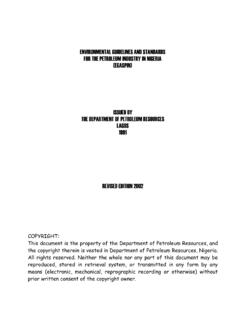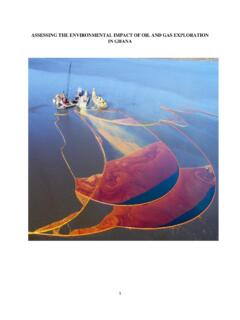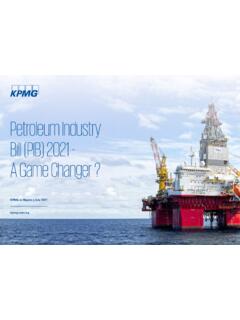Transcription of Methods of Exploration and Production of Petroleum …
1 UNESCO EOLSSSAMPLE CHAPTERSGEOLOGY Vol. V Methods of Exploration and Production of Petroleum Resources - Ione L. Taylor Encyclopedia of Life Support Systems (EOLSS) Methods OF Exploration AND Production OF Petroleum RESOURCES Ione L. Taylor Geological Survey, Reston, Virginia, USA Keywords: oil, natural gas, Petroleum geology, Exploration , drilling, well log, seismology, geophysics Contents 1. Introduction Background of the Petroleum industry 2. The Role of Geoscientists 3. The Exploration and Production (E&P) Process 4. Exploratory Drilling Phase 5. Conventional Exploration Phase 6. Field Development Phase 7. Production Phase 8. Unconventional Reservoirs Acknowledgements Glossary Bibliography Biographical Sketch Summary Methods of Petroleum Exploration and Production (E&P) typically involve expensive, technologically driven approaches.
2 During the prospecting phase, Petroleum E&P includes the use of subsurface geologic evaluation, seismic data and large computing power to process the geophysical data. Drilling exploratory wells is also an expensive and risky undertaking. All decisions about investments made in exploratory drilling, development, and Production are weighted against the potential economic return anticipated from the investment. 1. Introduction - Background of the Petroleum industry Demand for Petroleum products has grown continuously since the first discovery of large crude oil accumulations in the United States by Edwin Blake in 1859 near Titusville, Pennsylvania (see Petroleum (Oil and Gas) Geology and Resources, this volume; and Coal, Oil and Gas for the Twenty-first Century, this volume).
3 As a result, the Petroleum industry is now a major component of the global economy. Most Petroleum products derived from refining crude oil are combusted to provide energy as in diesel fuel, jet fuel, kerosene, fuel oil and gasoline. The burning of fossil fuels (coal, natural gas and oil) provides the vast majority of energy today and the dependence on Petroleum products is anticipated to continue into the foreseeable future (see Petroleum (Oil and Gas) Geology and Resources, Figure 1, this volume). However, there are a number of environmental concerns associated with the burning of Petroleum products. Concerns about air pollution, smog and greenhouse gas effects on global warming is UNESCO EOLSSSAMPLE CHAPTERSGEOLOGY Vol. V Methods of Exploration and Production of Petroleum Resources - Ione L.
4 Taylor Encyclopedia of Life Support Systems (EOLSS) causing a shift in the demand for liquid fuel towards greater use of natural gas (methane) for non-transportation needs. Natural gas, or methane, has many uses including home heating and cooking, electrical power generation plants, and as a feedstock for certain chemical processes. In addition to producing refined fuels, crude oil can also provide petrochemicals for wide range of uses, both as products themselves and as chemical feedstocks used to make other products. These petrochemical products include pharmaceuticals, plastics, synthetic rubbers, insecticides, fungicides, fertilizers, and lubricants. The value of the crude oil that provides heating fuel and fuel for internal combustion engines creates the incentive for investors, including national governments, to spend large amounts of money to search for it underground.
5 However, there is a great deal of risk associated with investing money in oil and gas Exploration because Petroleum deposits are generated by natural processes that commonly occur at great depth and are poorly understood and predicted by earth scientists. Financially there is a lot at stake and commercial failures can be very costly to the investor because Exploration wells often cost millions to hundreds of millions of dollars in deepwater and harsh environments; Exploration programs (property leasing, data collection and analysis, etc.) commonly cost in excess of one hundred million dollars, Oil industry investors and company managers commonly refer to the size of the prize when considering the investment risk in hydrocarbon Exploration . They ask themselves, Does the amount of Petroleum our geologists think is down there, justify the high cost of exploratory drilling and subsequent development program?
6 The goal of the investor/shareholder or company is to make money at a desired return of investment, not just to find oil or gas. In order to make money, the company must find, produce, and sell Petroleum at a profit that meets their financial goals? Many beginning oil company Exploration geologists or geophysicists get caught up in the technical aspects of subsurface analysis, but find out quickly that the business aspects of making money drive the technical work, not the other way around. This is a critical point to remember from this chapter on Methods of oil and gas Exploration . The Methods described in this chapter, which can be very high tech , cutting edge and expensive, are developed and used by oil companies and investors for one purpose only: to reduce the uncertainty of predicting the subsurface location, volume and nature of economic occurrences of Petroleum deposits.
7 The use of these Methods depends on whether the value of the information that they provide is expected to exceed the cost to employ them. Alternatively stated, the Methods employed in oil Exploration are driven by the business need to evaluate the investment risk relative to the monetary return expected. There are seven major conceptual steps involved in the complete commercial Petroleum Product Life Cycle (Figure 1). These steps are (1) Prospecting, (2) Leasing or acquiring access, (3) Drilling operations, (4) Developing and producing, (5) Transporting, (6) Processing and refining, (7) Marketing and sales. Of the seven steps listed above, the first three steps are called the Exploration phase and the forth step is the Production /extraction phase.
8 The majority of wildcat wells drilled to date have been dry holes that contained no commercial hydrocarbons. Wildcat drilling success rates in the industry have climbed from about a 10% success rate 20 years ago, to approximately 56% of wells discovering hydrocarbons currently. Thus steps 1 through 3 UNESCO EOLSSSAMPLE CHAPTERSGEOLOGY Vol. V Methods of Exploration and Production of Petroleum Resources - Ione L. Taylor Encyclopedia of Life Support Systems (EOLSS) in Figure 1 may need to be repeated many times before a successful venture that moves forward to steps 4 through 7 is achieved. Many geoscientists employed by the Petroleum industry refer to themselves as working in the upstream part of the business, or in E&P . This means the Exploration and Production aspects of the business.
9 Midstream business consists of transportation and refining (steps five and six). The downstream business deals with marketing and sales (step seven), which is represented by the gasoline stations that are familiar to many consumers. This chapter addresses only the Methods employed by those engaged in the Exploration and Production phases of the Petroleum industry . In addition, this chapter focuses on the role of the geoscientist in E&P, and does not provide detail on the role of other disciplines such as economics and engineering. National Oil Companies (NOC s) that are owned and directed by national governments are subject to rules and regulations outside of the commercial marketplace. Their motives and objectives may involve energy supply and security for their citizens rather than strictly financial investment return.
10 Thus they may not need to conduct steps two and seven above, or these and other steps may be greatly modified from those undertaken by industrial enterprises. Figure 1. The Petroleum Product Life Cycle 2. The Role of Geoscientists The majority of geoscientists employed in the search for oil and gas fall into one of three sub-specialties. Although there can be much overlap, these three sub-specialties are as follows: geologists (understanding the rocks), geophysicists (interpreting the subsurface structure or configuration through seismic, gravity, etc.) and geochemists (understanding the subsurface fluids, like Petroleum ). Geoscientists are employed by oil Exploration and Production companies because of their expertise in applying earth science to predict subsurface conditions and processes at work in sedimentary basins that form the hydrocarbon habitat for oil and gas deposits.


















